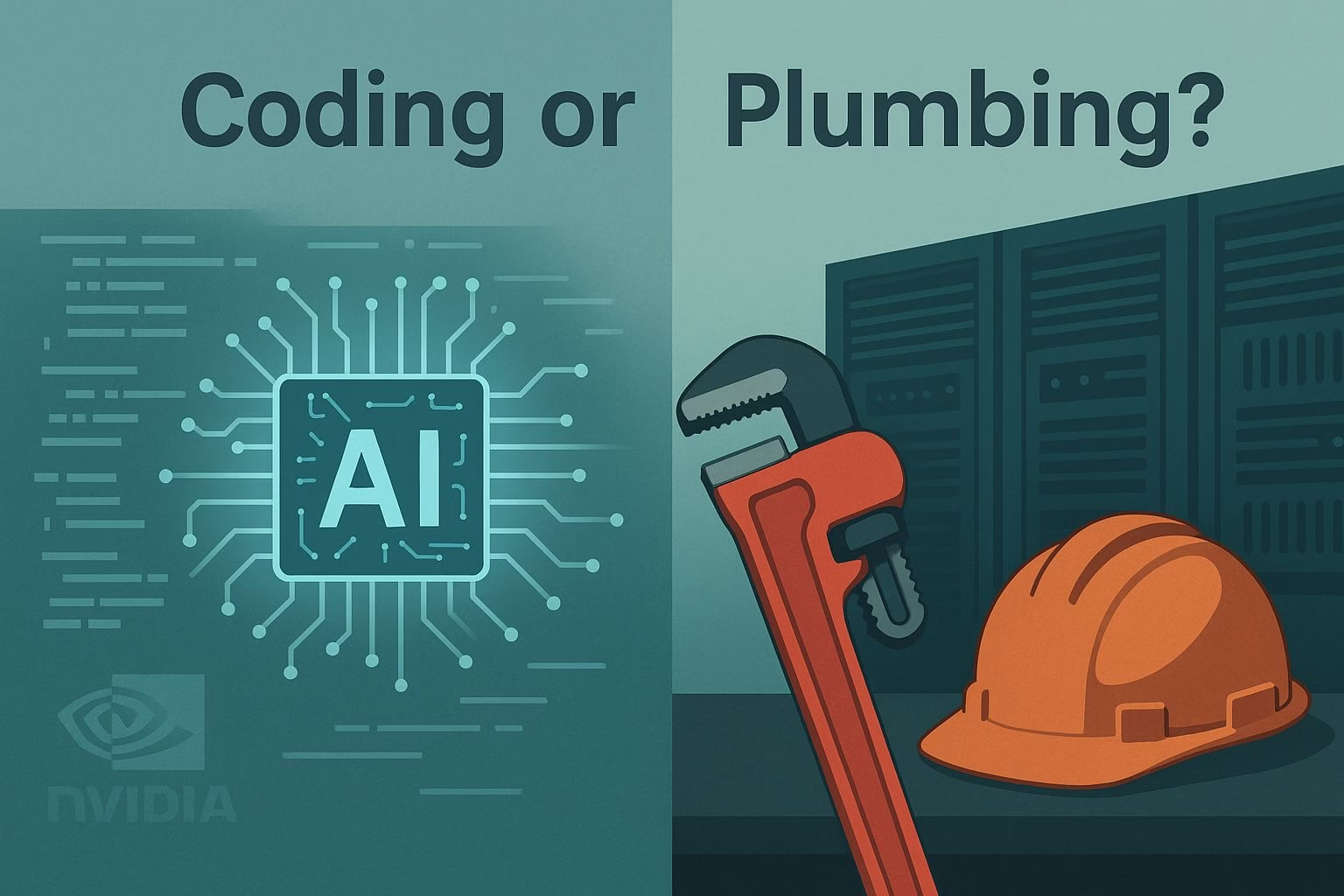Nvidia CEO Tells People to Skip Coding and Become Plumbers
Quick summary
- Jensen Huang’s “skip coding” and “learn trades” lines both support Nvidia’s growth. One drives AI tool adoption while the other drives data center build-outs.
- Skilled trades shortages predate AI. The boom increases demand, but did not create it.
- CEO advice often mirrors the company’s strategy. Build adaptable skills across code and trades instead of chasing trends.
When Nvidia’s CEO Jensen Huang first said that “nobody needs to program anymore,” it sounded like the end of coding as we know it.
Then, months later, he told young people to forget software careers and learn plumbing or electrical work instead.
Both messages spread fast, mostly because they seemed to completely contradict each other.
I remember thinking how strange it was to hear the same person say two totally different things about the future of work.
One minute, we’re all “programmers” because AI can handle code. The next, we’re told to pick up wrenches and wire data centers. Something about that shift didn’t feel like genuine advice.
These statements have less to do with education or career guidance and more to do with Nvidia’s own business goals. Each comment perfectly aligns with the company’s interests, not with the realities of everyday workers.
That’s the real story behind these sound bites.
How Nvidia Benefits From Both Narratives
Jensen Huang’s two statements might sound inconsistent, but both help Nvidia grow its market.
When he said AI would make everyone a programmer, he was selling the idea that anyone can use AI tools to create software.
That message pushes people toward AI platforms, which depend on Nvidia’s GPUs for processing. More AI usage means higher demand for chips, and that’s good for business.
Later, when he told young people to skip coding and focus on trades like plumbing and electrical work, the message shifted to another Nvidia need: physical infrastructure.
Massive data centers don’t build themselves. They require electricians, plumbers, and construction specialists to install cooling systems, wiring, and power grids.
The AI boom relies on these trades as much as it relies on coders. By promoting this angle, Huang was still marketing Nvidia, just to a different audience.
You can see his plumber statement on Fortune here, and his earlier AI replaces coding quote on TechRadar here.
When viewed side by side, both messages create a complete ecosystem: more AI users and more people to build the systems that support AI. Either way, Nvidia wins.
Even if these comments sound like career advice, they serve as indirect marketing.
Nvidia’s profits depend on AI’s growth, so any narrative that keeps people engaged with AI, whether through tools or trades, works in its favor.
It’s less about predicting the future and more about shaping it for the company’s benefit.
Why the “Learn a Trade” Message Still Resonates
Despite the corporate spin, Huang’s focus on trades touches a real trend. Skilled labor shortages have been growing for years, long before AI took over headlines.
Many students were told that college was the only path to success, while fewer entered apprenticeships or hands-on careers.
As a result, electricians and plumbers are now in short supply and often earn six figures in major cities.
The AI boom is amplifying that gap, not creating it. Data centers, electric vehicle plants, and renewable energy projects all depend on reliable tradespeople.
AI only adds pressure to a system that already needed more hands. So while Huang’s timing may serve Nvidia’s interests, the core of what he’s saying isn’t completely wrong.
There’s real opportunity in skilled trades.
That said, the message oversimplifies the problem. These jobs aren’t a safety net for everyone, and not all trade work pays equally.
Apprenticeships are competitive, and many entry-level workers earn low wages for years before they see real growth.
Telling an entire generation to switch from coding to plumbing skips the nuance that defines actual labor markets.
What stands out is how easily public figures can steer career narratives to match economic cycles. When tech looks risky, we hear “go into trades.”
When AI grows again, we’ll hear “learn prompt engineering.” Both are trends, and both are short-term responses to deeper shifts in the economy.
The Economics Behind the Contradiction
Both of Huang’s statements follow the same logic of supply and demand. When AI tools automate parts of coding, they increase the number of people who can create simple software.
That reduces the value of entry-level programming jobs. At the same time, the global demand for data centers creates new opportunities for physical labor such as plumbing, wiring, and construction.
These are tasks AI cannot replace.
By steering attention toward trades, Huang positions Nvidia as part of the solution. His company’s chips power the AI models that require those data centers.
The more centers built, the more GPUs Nvidia sells. When he talks about plumbing, it is really about driving more investment into infrastructure that benefits his company.
Some Reddit users pointed out that billionaires often shape advice to fit their business goals. They compared Huang to Elon Musk and Peter Thiel, saying he is simply protecting Nvidia’s long-term profits.
One comment said it clearly: “Good for Nvidia equals good for his bank account.” The career advice may sound useful, but it mainly serves investors.
Still, there is a real economic trend behind it. Skilled trades are better paid today because fewer people chose them for decades.
The gap in supply was already growing before AI became popular. The AI boom only draws more attention to that shortage.
How AI Career Advice Keeps Changing
The job market around AI changes faster than almost any other field. Every few months, new predictions claim that coding is finished, only for companies to keep hiring developers.
Tools like GPT can write simple code, but they still need people to define logic, review structure, and maintain systems.
The idea that AI will replace programmers has existed for years, yet the world still needs more of them.
New AI-related jobs appear instead. People now work as prompt engineers, AI supervisors, and system trainers.
These roles require an understanding of both coding and reasoning, even if they do not involve writing lines of code. Knowing how to manage AI tools is quickly becoming as valuable as technical skills once were.
The challenge is that public figures present these shifts as revolutions rather than adjustments. Each generation hears that technology will destroy one field and create another.
In practice, people adapt, and the market balances out. Technology changes how we work, not whether we can.
That is why advice from CEOs rarely helps in real life. Their statements sound confident because confidence sells. The real path forward is to stay flexible, keep learning, and focus on skills that connect across industries.
Whether that means coding, trades, or both, the key is to stay adaptable rather than follow trends built around quarterly earnings.

